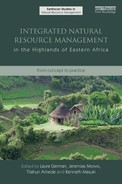FIGURES
1.1 Map of eastern Africa showing AHI mandated areas and the benchmark sites
1.2 Illustration of the relationship between action research (upper box) and PAR (lower box)
2.1 Simplified model of farm level entry point and linked technologies
2.4 Levels of technology “spillover” relative to project interventions
3.2 Baga watershed demarcated using (village) administrative boundaries
3.4 Soil and water management cluster
3.5 Integrated production and nutrient management cluster
3.8 Observed impacts from collective action in porcupine control
4.2 Livestock holdings by wealth category in four AHI benchmark sites
4.3 UWA communication and decision-making channels on co-management
5.1 Operational framework for participatory policy action research
5.2 Gendered patterns of participation in by-law meetings over time in pilot communities
5.3 Information flow in demand-driven information provision
5.4 Use of VICE phones in 2008, Rubaya Sub-County, Kabale District, Uganda
6.1 Scaling out and scaling up in AHI
6.3 Cornerstones for effective research in Ethiopia and Tanzania
Colour plate section (between pages 146 and 147)
1 Farmers in Kwalei village, Lushoto, load up their tomatoes for transport to Dar es Salaam
2 Metallic hook used to trap mole rats in Areka
4 Spring in Kwekitui Village, Lushoto, which yields much less water today than in the past
5 Tolil Watershed Committee in Kapchorwa, Uganda
6 Village representatives involved in participatory watershed planning in Lushoto, Tanzania
8 Introduction to the watershed approach to farmers in Rwanda
10 Ginchi landscape prior to soil conservation interventions
11 Ginchi farmers exploring terraced landscape at Konso
13 Cultivation up to the edge of a spring in the Baga watershed, Lushoto
14 Landscape with (bottom) and without (top) natural resource governance
